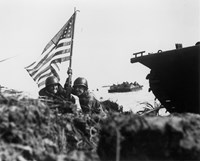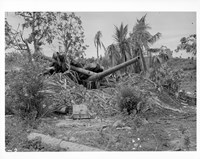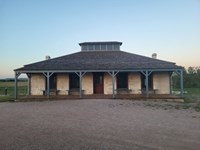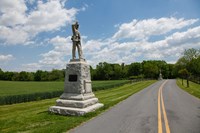- Golden Gate National Recreation Area (48)
- Lewis & Clark National Historic Trail (17)
- Boston National Historical Park (16)
- Presidio of San Francisco (16)
- Charles Young Buffalo Soldiers National Monument (12)
- Boston Harbor Islands National Recreation Area (9)
- Fort Sumter and Fort Moultrie National Historical Park (9)
- Sleeping Bear Dunes National Lakeshore (9)
- Cabrillo National Monument (8)
- Show More ...
- Geologic Resources Division (4)
- National Register of Historic Places Program (3)
- National Center for Preservation Technology and Training (2)
- American Battlefield Protection Program (1)
- Klamath Inventory & Monitoring Network (1)
- Law Enforcement, Security, and Emergency Services (1)
- National Historic Landmarks Program (1)
- National Natural Landmarks Program (1)
- Research Learning Centers (1)
- Show More ...
Showing 361 results for gun emplacements ...
Charles Robinson
A Stunning Defeat Wayside Exhibit
- Type: Person

Mrs. Recy Taylor was just 24 years old when she was brutally raped by six white men in Alabama. Upholding the Black woman's tradition of testimony and protest, Taylor actively participated in the pursuit to bring her attackers to justice. Though the men were acquitted in two separate trials, Taylor's courage speaks to the resolve of Black women to channel their pain and anger into political anger. We honor Taylor as an ancestor for teaching us a lesson on courage.
Agat Unit - Apaca Point and Ga'an Point
- Type: Place

Hågat (Agat) Beach was the southern landing beaches used during the Battle of Guam. The rocky outcrops along the beach had been well fortified with caves and bunkers built directly into the limestone headland. With gunports for eyes and rocky ridges for armor, Japanese soldiers turned the terrain itself into a deadly defense. Today, the remains of those fortifications, as well as two examples of Imperial Japanese guns, stand against a backdrop of clear blue ocean.
Fonte Plateau
- Type: Place
Asan Beach Unit
- Type: Place

In 1944, this seaside park, known locally as Assan Beach Park, was the site of fierce fighting. Assan Beach was the northern most of the two landing beaches used by American troops during the first days of the Battle of Guam. Today, the Asan Beach Unit is home to remains of the Imperial Japanese defenses and memorials to those who died during the battle.
Assan/Asan Beach
- Type: Place

During the Japanese occupation of Guam, CHamoru were forced to build defenses on the beach, including the pillboxes and bunkers that can still be seen today, in preparation for the American invasion. That invasion came on July 21, 1944, W Day for Guam. While a simultaneous attack took place five miles south at Hågat, the Third Marine Division landed on the 2,500-yard Assan Beach, marking the start of the Battle of Guam.
Labor Reforms of the Port Royal Experiment
- Type: Article

Paying wages to the formerly enslaved people served two purposes for the government officials developing the Port Royal Experiment. It helped to provide a solution of where people should live. Wages also began to put cash into the hands of people who had toiled this land for generations. Many sought to use that cash to secure that land for themselves.
The Port Royal Experiment
Series: The Port Royal Experiment
- Type: Article

In the fall of 1861 after the Battle of Port Royal, the US military came ashore around Beaufort and found thousands of now formerly enslaved people in control of the region. The military had no real plan yet for what to do with these people or even their legal status. Newly freed Black South Carolinians were active participants. They demanded access to programs to support labor reforms, land redistribution, quality education, and military service.
Piti Guns Unit
- Type: Place

During the last months of the Imperial Japanese occupation of Guam, Japanese defenders heavily fortified the island in preparation for the coming battle. Machine guns, artillery and mortar emplacements, and coastal defense guns were installed on the high ground near the coast. Today, most of those fortifications are either gone, but in the hills overlooking the village of Piti, three Vickers-type Model 3 140mm coastal defense guns still rest silently in a mahogany forest.
Piti
- Type: Place

Above the village of Piti, sit three large Japanese Vickers-type Model 3 140mm coastal defense guns, the remains of hastily constructed fortifications build on the eve of the American invasion of Guam. As the Americans conquered more and more territory in the Pacific, the Japanese forced the CHamoru to build fortifications and install artillery and costal defense guns on Guam under brutal conditions.
Land Ownership: An Effect of the Port Royal Experiment
Captain James Ricketts' Artillery Position
Captain Charles Griffin's Howitzers
4th Pennsylvania Reserve Monument (33rd) Volunteer Infantry Monument
45th Pennsylvania Infantry Monument
Dentzel Carousel
A Hearty Grip: Fort Scott Soldiers in the Mexican- American War
- Type: Article

Imagine the fear you might have marching into battle with guns blazing all around you. Imagine the courage it took to charge an enemy when their cannons thundered at you from a fortified hilltop. Imagine fighting in a foreign country far from home against a determined foe and waging a war that half of your country opposes. Imagine putting your life in danger on a daily basis. Such was the experience of Fort Scott soldiers during the Mexican-American War.











